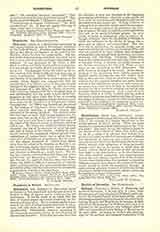

Dithmar (THIETMAR), Bishop of Merseburg and medieval chronicler, b. July 25, 975; d. December 1, 1018. He was a son of Count Siegfried of Walbeck and a relative of the imperial family of the Saxon Ottos. After receiving his education in the monastic schools of Quedlinburg, Bergen, and Magdeburg, he became, in 1002, provost of the monastery of Walbeck which had been founded by his grandfather, was ordained priest in 1003 and consecrated fourth Bishop of Merseburg on April 24, 1009. As bishop he worked with great energy for the spiritual and temporal restoration of his diocese which had been almost ruined by Giseler, the second Bishop of Merseburg, in his unholy ambition to become Archbishop of Magdeburg in 981. At the same time he fearlessly defended the canonical liberty of ecclesiastical elections against the encroachments of the secular princes.
While Bishop of Merseburg he composed his famous chronicle “Chronicon Thietmari”, which comprises in eight books the reigns of the Saxon Emperors Henry I (called the Fowler), the three Ottos, and Henry II (the Saint). The first three books, covering the reigns of Henry I and the first two Ottos, are largely based on previous chronicles, most of which are still extant; the fourth book, comprising the reign of Otto III, contains much original matter; while the remaining four books, which describe the reign of Henry II to the year 1018, are the independent narrative of Dithmar. As councillor of the emperor and participant in many important political transactions, he was well equipped for writing a history of his times. The spirit of sincerity which pervades his chronicle is abundant compensation for the barbarous expressions which occasionally mar the literary style. The last four books, besides being the principal source for Saxon history during the reign of the holy emperor Henry II, contain valuable information, not to be found elsewhere, regarding the contemporary history and civilization of the Slavic tribes east of the river Elbe, especially the Poles and Hungarians. Dithmar’s original manuscript, with corrections and additions made by himself, is still preserved at Dresden. A facsimile edition of it was prepared by L. Schmidt (Dresden, 1905). The chronicle was also published by Kurze in “Script. Rer. Germ.” (Hanover, 1889), and by Lappenberg in “Mon. Germ. Hist.: Script.” III, 733-871, whence it was reprinted in Migne, P.L., CXXXIX, 1183-1422. A German translation was made by Laurent (Berlin, 1848, and Leipzig, 1892).
MICHAEL OTT

